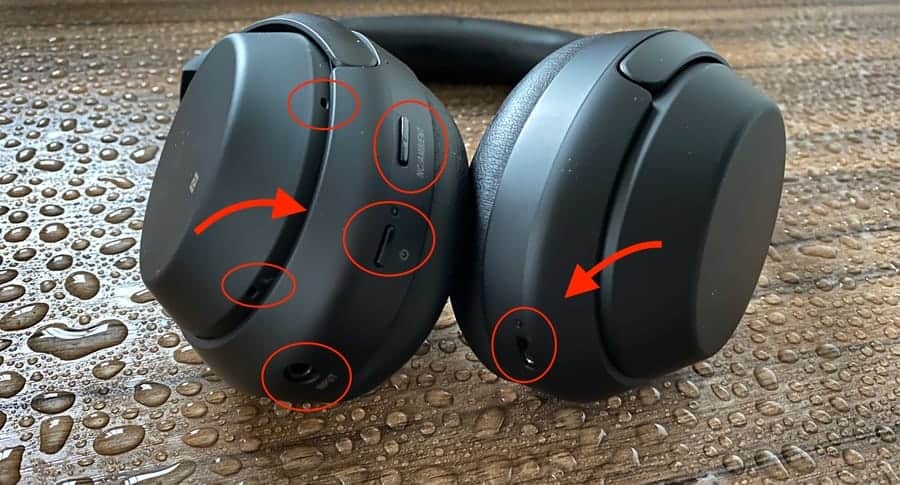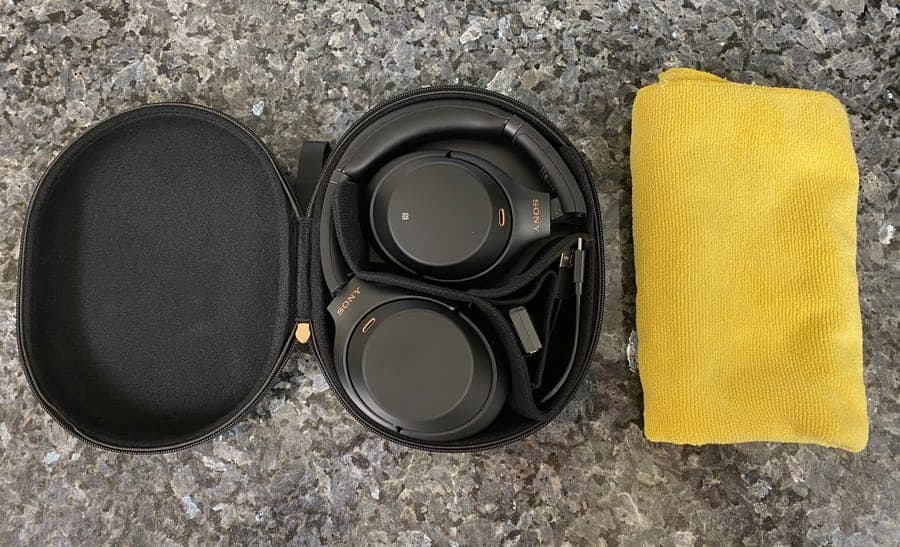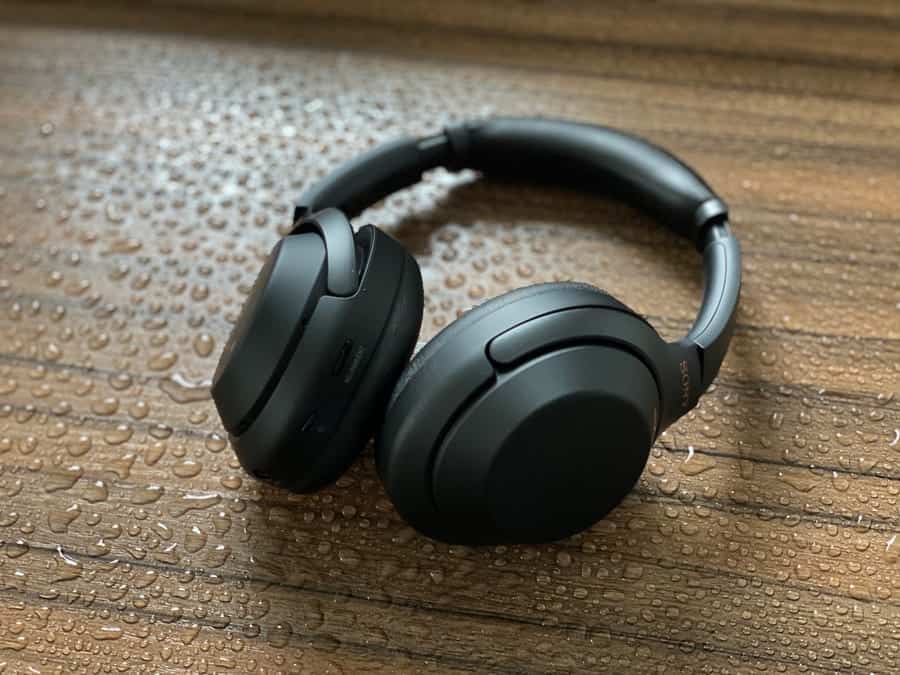If you’ve been reading any of my previous posts covering the Sony WH-1000XM3 wireless headphones thus far, you will know that I’m really enjoying and experimenting with them: in this case, finding out if they are sweat proof or waterproof.
So let’s get right into it. Are Sony WH-1000XM3 bluetooth headphones sweat proof and waterproof?
According to the manufacturer, the Sony WH-1000XM3 wireless headphones are not splash proof or waterproof, and are not designed to be worn in environments with high humidity. The ear cushions are also not designed to be sweat proof or waterproof, and can become excessively worn if they are exposed to moisture.
Although these headphones can get damaged in wet environments, this doesn’t mean that they can’t be worn as part of an active lifestyle, like traveling and commuting.
Read on below as I get into more detail on what I’ve researched about how the WH-1000XM3 holds up (or doesn’t) to water and sweat, as well as some tips on how to make sure your XM3s stay protected while on the go.
Are Sony WH-1000XM3 Wireless Headphones Sweat Proof or Waterproof?
We’ve more than likely seen the Sony WH-1000XM3 headphones photographed in a variety of environments, including at home, traveling on an airplane, or even being worn outside.
Since these headphones are shown in so many facets of one’s lifestyle, I was curious as to if the 1000XM3s are sweat proof, or even waterproof.
Here’s what I discovered:
According to the manufacturer, Sony strongly does not recommend getting the WH-1000XM2 and WH-1000XM3s wet. This is their official statement:
“The WH-1000XM2 & WH-1000XM3 Wireless Noise Cancelling models are not waterproof, splash-proof or intended to be used in a humid environment. If water or other liquids enter your product, it may cause damage, risks of fire or electric shock.”
Source: Sony corporation
It’s important to emphasize that the company doesn’t want Sony noise-cancelling headphone users to get excess moisture on any of the electrical components that are found inside the structure of these headphones because they are not sealed and protected from the elements.
In fact, earbuds and headphones that are waterproof to a certain depth of water are rated this way because their inner components are coated and sealed so that water cannot reach them, or if it does, will not harm them.
If you look at a pair of waterproof headphones, such as the Plantronics Backbeat Fit for example, you’ll notice that there aren’t any exposed buttons, charging ports, or microphone openings of any kind.
Manufacturers that sell waterproof-rated headphones eliminate critical openings that can allow moisture to damage the most delicate electronics inside them, even going so far as to design drivers that push sound out but not let moisture in.
So let’s return to the WH-1000XM3 and the official statement from Sony regarding their lack of sweat and waterproof rating.
It’s clear when inspecting these wireless noise cancelling headphones that water and sweat have a much higher chance of damage than compared to drenching headphones that are designed to withstand moisture.
Below are the areas where exposure to a wet or humid environment could pose a very real risk for the XM3s.
A Critical Look at the WH-1000XM3 and It’s Risk Of Damage From Water or Sweat.

Taking a careful look around the ear cups and headband of the Sony WH-1000XM3, there are many indicators that these are, in fact, not sweat or waterproof, nor should this be an area of experiment.
The first, and most obvious, is looking around the bottom outside edge of the left and right ear cups.
Along the bottom of the right ear cup is the 1000XM3s USB-C charge port and charging indicator light. Here around this spot, the biggest risk of water and sweat damage is inside the charge port. It is completely exposed, with no plugs, seals, or covers whatsoever.
Waterproof headphones mostly have a protective barrier that prevents water from entering the charge port. This one does not.
Checking out the left ear cup, there are many more areas where moisture can enter and damage components inside.
Starting with the two buttons: the NC/AMBIENT button that controls the noise cancelling function, and the POWER button.
Both of these buttons have exposed openings around their edges and have no rubber barrier that would protect water or sweat from coming in.
Similar to the USB-C port, on this side the INPUT 3.5mm headphone jack poses another real risk to water damage because, again, there is no protective cover or seal.
As a comparison, a waterproof headphone would have either no 3.5mm headphone jack, or one that avoids moisture with a plug or cover.
Finally, and probably most importantly, are the two tiny microphone openings further outside the bottom edge of the ear cup.
I see two problems here if they become exposed to water or sweat:
- Both openings are completely exposed with no cover or signifier that they are protected from the elements.
- The location of these mic openings are more frightening to me: they are placed right next to the sound driver of the ear cup. Getting water in here could result in true wrecking of havoc for the XM3s.
Sony was right… we really shouldn’t expose these ear cups to anything remotely humid or wet.
A couple more confirmations of their official statement that catch my eye include looking at the hinges below the headband adjustment and the soft high-quality ear cushions.
It’s cool that Sony designed these headphones with so many options to bend, turn, and swivel so that they can pack tight and fit our heads as comfortable as possible.
However, each of these hinges is an obvious opening that could allow water and sweat to enter. If this happens, the moisture could corrode the hinges and significantly compromise functionality.
Worse… water could continue to run down along the inside of the hinge and enter the ear cups where all the battery and sound components of the XM3s are located (yikes!).
The plush ear cushions that come with the 1000XM3s are another story.
Feeling, wearing, and pushing on them, I can tell that these cushions are not performance-oriented. They are gentle and somewhat porous in nature. Getting them wet could cause excessive wear.
Sony confirms this. Also warning in their statement regarding sweat and waterproof rating, that if you are:
“Using the headphones while you are sweaty. Sweat, wet hands or damp clothing can negatively affect the product: it can degrade the earpads…”
source: sony corporation
Getting the ear cup cushions wet or stained in sweat could rub the leather covering, get inside the cushioning, and even deform the structure of the pads themselves.
This could severely impact the overall seal that it has around the ear, and hamper the effectiveness of the noise cancellation function.
Can You Wear Sony WH-1000XM3 Headphones in the Rain?
Considering the information I discovered about the Sony WH-1000XM3s sensitivity to water and sweat, it makes sense to look at these headphones within the frame of an active lifestyle: including wearing them outside.
So say someone is wearing the XM3s outside and it starts to rain, is it a good idea to continue wearing them?
Since Sony notes that these headphones are not only prone to electrical damage from water and sweat, but also from any humid environment, rain could also greatly increase the chances that the 1000XM3s get damaged inside.
Although the outside structure of the XM3s look fairly rugged with its hard plastic architecture, there’s several critical openings around the noise cancelling mic, call mic, the buttons, charge port, and 3.5mm headphone jack that if introduced to moisture of any kind could severely damage the electrical components inside.
It doesn’t help that Sony placed all of these water-sensitive openings along the bottom edge of the ear cups because, especially in the case of rain, the water will travel down with gravity and collect at the bottom of each ear cup (where these openings are located!).
Rain can also cause excessive wear to the plush ear pad cushions and impact their seal, which allows the noise cancellation function to work so effectively inside the ear cup while being worn.
As a result, it’s strongly not recommended to wear the WH-1000XM3s in the rain.
If you are wearing these headphones and find yourself caught wide open in a rain storm, you should remove and place them in a case, bag, or any other environment that can keep them dry and away from water.
Keeping the 1000XM3 headphones dry, even if the rain is just a drizzle, will extend their life and significantly protect them from any intermittent electronic issues that could arise as a result of water damage, such as a lack of connectivity, noise cancellation, call clarity, or sound performance.
Are the Sony WH-1000XM3 Wireless Headphones Ideal For Working Out?
Coming from the perspective of sweat and waterproofing, the Sony WH-1000XM3 are not ideal for working out because these headphones are not designed to be protected from excess moisture.
In many cases, working out leads to not just more water, but more sweat that runs along the outside of headphones.
Compared to headphones which are designed and rated to be sweat and waterproof, the Sony WH-1000XM3 headphones have several components that are prone to water and sweat damage.
Not only that, but almost all of these openings are located at the bottom of each ear cup, including buttons, its charge port, and microphones.
This means that, if during an intense workout, sweat were to run down along these headphone (thanks to gravity), it would accumulate right by where these risky entry points are.
Since sweat contains additional chemicals to water, if it enters through any of the openings along the bottom of the WH-1000XM3, it can corrode the electrical components that are inside the ear cups.
Electrical corrosion from sweat can lead to several issues, including lack of button functionality, charging, bluetooth connection, call clarity, or noise cancellation.
Sweat can also build up around the buttons and prevent them from working properly, resulting in them becoming stuck, or jammed completely.
Since the ear cushions of the XM3s are also not designed for sweat protection, exposure can lead to quick and excessive wear around the pads and also weaken its structure, which is critical for proper noise cancellation.
Bottom line: The Sony WH-1000XM3 have some of the best electrical features on the market, including a strong bluetooth connection, sound customization with the included EQ app, and cocooning noise cancellation. But the lack of seals around buttons and ports makes these headphones prone to water damage from sweat, and are therefore a risky option for working out.
Tips To Cleaning and Protecting Sony WH-1000XM3 headphones

Since these headphones don’t take to handling water, sweat, and humidity kindly, it’s a good idea to keep the Sony WH-1000XM3s as clean, dry, and protected as possible from the elements.
First, and if you can manage, try to keep the included carrying case that came with the 1000XM3s as much as possible, whether its traveling, commuting, or anywhere around your desk.
This hard case is extremely nice, and since it features a zipper, can keep the XM3s protected from impacts and water.
Now I don’t think you can submerge the included case in water (not waterproof) but it should be able to handle rain, splashes, and spills just fine.
Also, monitor the appearance of the WH-1000XM3 headphones as you wear them over time, since there will most likely be an accumulation of oils from you hair and skin found around the headband and ear cups.
This is completely normal, but to extend the life they should be wiped clean on a regular basis.
Avoid harsh cleaning chemicals and wet cloths to wipe clean your WH-1000XM3s.
Instead, start with using a dry soft microfiber or eye lens cloth to wipe oils and any accidental spills around the headphones.
If a more aggressive approach is needed to clean, use a slightly damp cloth that has been thoroughly rung out, so as to avoid the risk of water damage. Also avoid wiping the damp cloth near any ports, mic openings, or buttons (found mostly around the bottom of the ear cups).
If any kind of moisture does get in to any of the ports or openings, use a small, thin piece of cotton, like a swab or Q-Tip, to reach inside and dry the wet area as soon as possible.
Recommended Products That Helped Me to Research This Article:

- Sony WH-1000XM3 Wireless Noise Cancellation Headphones (for a great price I bought on Amazon) – My go-to over ear headphones for pretty much anything that involves the need for audio. It seems like I never have to worry about charging them thanks to its awesome 30 hour battery life, and the noise cancellation is so good that I find myself many times using this function even without listening any audio. Customizing bass, mids, and treble with the included EQ app is a nice touch as well.
